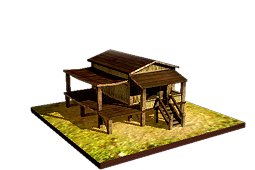Rice Farms (ETW building)
| Rice Farms | |||||
|---|---|---|---|---|---|
| Category: | Farm | ||||
| Level: | 1 | ||||
| Turns to build: | 2 | ||||
| Building cost: | 600 | ||||

| |||||
| Requires | |||||
| Rice Paddies | |||||
| Technology | |||||
| Common Land Enclosures | |||||
| Enables | |||||
| |||||
By introducing organisation beyond the simple hand-to-mouth methods of peasantry, rice yields are improved.
Rice does require extensive earthworks in terms of ditches, dykes and watercourses. Without a substantial and controllable supply of fresh water, crop yields will suffer. By moving away from a peasant-level growing pattern, where each farmer is responsible only for his fields and nothing else, a rice farm takes maximum advantage of the available land and water supply.
Although rice is an important crop, it is not a complete diet in itself. The causes and cures of dietary “diseases” (actually, deficiencies) were dimly understood by 18th medical men, if indeed they were seen as being problems caused by poor diet at all. Doctors knew fresh food helped people with scurvy, but why this worked was a complete mystery. Other dietary mysteries, such as beriberi, were equally impenetrable. In that case, white rice, often seen as a higher-status dish than brown, un-husked rice, can be the cause of beriberi. Rice husk contains a relative large amount of thiamine (vitamin B1), the lack of which causes beriberi, a crippling condition. The causes and cure for beriberi, which was endemic in some parts of Asia, remained unknown until the early 20th Century.

